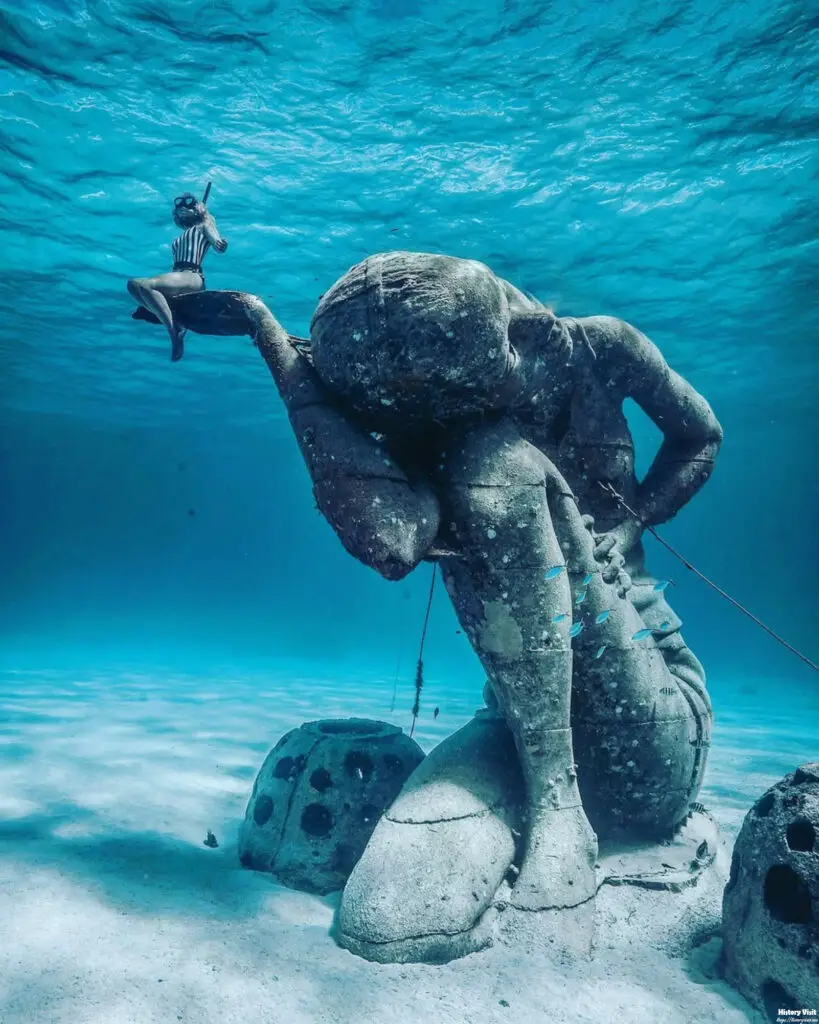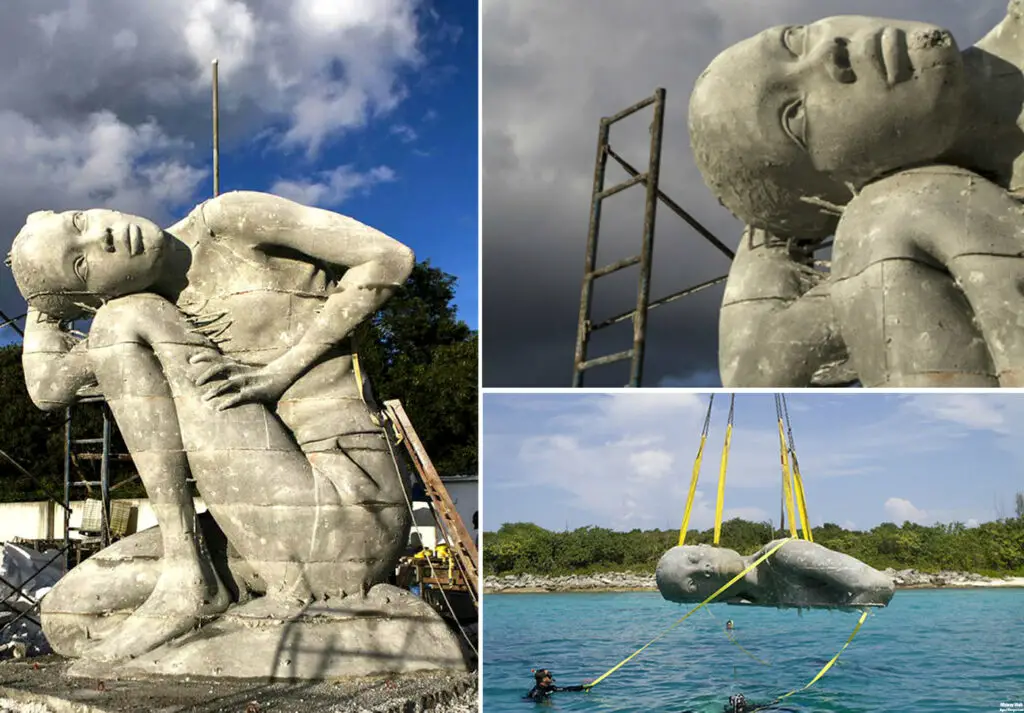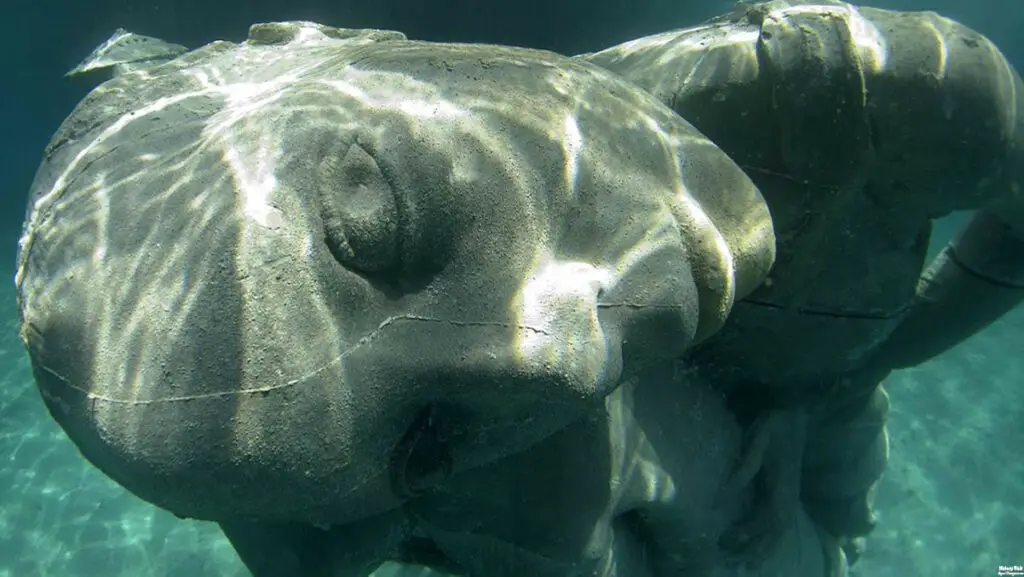Ocean Atlas: The World’s Largest Underwater Sculpture

Introduction
Beneath the azure waves off the coast of Nassau in the Bahamas lies a remarkable fusion of art and environmentalism: “Ocean Atlas,” the world’s largest underwater sculpture. This monumental work, created by British sculptor Jason deCaires Taylor, serves as both an artistic marvel and a beacon of ecological consciousness. Installed in October 2014, “Ocean Atlas” stands over 5.48 meters (18 feet) tall and weighs approximately 60 tons, depicting a young Bahamian girl bearing the weight of the ocean on her shoulders in a poignant nod to the ancient Greek Titan, Atlas.
The sculpture’s grandeur and intricate detail immediately captivate those who encounter it, but its significance extends far beyond its aesthetic appeal. Constructed from pH-neutral marine cement, “Ocean Atlas” is designed to foster coral growth and attract marine life, transforming into a thriving underwater habitat over time. This dual-purpose design underscores the urgent need to address the damage inflicted on natural reefs by human activities and environmental changes, offering a creative solution through the integration of art and conservation.
“Ocean Atlas” also plays a crucial educational role, raising awareness about the importance of ocean conservation and the responsibilities we all share in protecting marine ecosystems. As part of the Bahamas Reef Environment Educational Foundation’s (BREEF) initiatives, the sculpture invites snorkelers, divers, and the global community to reflect on our impact on the oceans and to engage in sustainable practices. Through its powerful imagery and ecological function, “Ocean Atlas” stands as a testament to the transformative power of art in inspiring environmental action and fostering a deeper connection to the natural world.
An Artistic Marvel

Created by British sculptor Jason deCaires Taylor, “Ocean Atlas” was unveiled in October 2014 as part of an initiative by the Bahamas Reef Environment Educational Foundation (BREEF) to raise awareness about ocean conservation. Taylor, known for his underwater sculptures, designed “Ocean Atlas” to be both an artistic and environmental masterpiece. This sculpture, standing over 5.48 meters (18 feet) tall and weighing approximately 60 tons, is the largest of its kind. It portrays a young Bahamian girl seemingly carrying the weight of the ocean on her shoulders, evoking the ancient Greek Titan Atlas, who bore the sky.
The detailed craftsmanship of “Ocean Atlas” is immediately striking. The figure’s serene expression and the graceful pose highlight Taylor’s attention to anatomical accuracy and emotional depth. Her upward gaze suggests both the burden and the hope associated with the responsibility of preserving the oceans. The sculpture’s surface, designed to weather the elements, will change over time, creating a dynamic interaction between the art and its environment.

The sculpture’s placement underwater adds another layer of complexity to its artistic appeal. Unlike traditional sculptures housed in galleries or museums, “Ocean Atlas” is subject to the natural ebb and flow of the sea. Light refracts differently underwater, casting varied and ever-changing shadows across the figure. This interplay of light and water enhances the sculpture’s ethereal beauty, offering divers a unique visual experience every time they visit.

“Ocean Atlas” not only captivates with its scale and beauty but also with its profound symbolism. It stands as a poignant reminder of humanity’s role in protecting the oceans. The depiction of a young girl bearing such a significant burden underscores the urgency of passing on the responsibility of environmental stewardship to future generations. This powerful imagery aims to inspire a sense of duty and action among viewers, urging them to contribute to ocean conservation efforts.
A Submerged Sanctuary

“Ocean Atlas” serves a dual purpose: it is a stunning piece of art and a functional artificial reef. Taylor constructed the sculpture from pH-neutral marine cement, specifically engineered to promote coral growth and attract marine life. By providing a substrate for corals to attach and grow, the sculpture helps to mitigate some of the damage inflicted on natural reefs by climate change, pollution, and overfishing. As such, it plays a vital role in enhancing local marine biodiversity.
The sculpture’s strategic placement in shallow waters makes it accessible to snorkelers and divers, who can observe the transformation of “Ocean Atlas” over time. As marine organisms colonize the structure, the sculpture becomes encrusted with corals, algae, and other sea life, evolving into a vibrant underwater habitat. This process not only benefits the ecosystem but also enriches the visual impact of the artwork, blending human creativity with the natural world.

Since its installation, “Ocean Atlas” has become a magnet for marine life. Fish, crustaceans, and various invertebrates have made the sculpture their home, turning it into a bustling underwater community. This influx of marine species not only enhances the ecological value of the site but also provides scientists and conservationists with a living laboratory to study the dynamics of artificial reefs and their role in marine conservation.
By drawing tourists and divers to the site, “Ocean Atlas” also generates economic benefits for the local community. Increased tourism can lead to greater awareness and funding for marine conservation efforts, creating a positive feedback loop that supports both the environment and the local economy. The sculpture’s role as a submerged sanctuary highlights the potential for art to drive environmental and social change, fostering a deeper connection between people and the oceans.
Environmental Impact and Legacy

Jason deCaires Taylor is renowned for his innovative use of art to promote environmental sustainability, and “Ocean Atlas” is a quintessential example of his vision. The sculpture’s design and material composition reflect a deep understanding of marine ecology and a commitment to conservation. By creating a habitat that supports coral growth and marine life, Taylor addresses the critical issue of reef degradation, offering a creative solution to a pressing environmental problem.
The ecological benefits of “Ocean Atlas” are substantial. By alleviating the pressure on natural reefs, the sculpture helps to preserve these fragile ecosystems, which are vital to the health of the oceans. Coral reefs provide essential services, such as protecting coastlines from erosion, supporting fisheries, and fostering biodiversity. By contributing to the restoration of these ecosystems, “Ocean Atlas” plays a crucial role in maintaining the ecological balance of the region.

Beyond its immediate environmental impact, “Ocean Atlas” serves as an educational tool that raises awareness about the importance of ocean conservation. The sculpture’s installation has sparked interest and curiosity, drawing attention to the challenges facing marine environments. Educational programs and guided tours of the site provide visitors with valuable insights into the significance of coral reefs and the need for sustainable practices to protect them.
The legacy of “Ocean Atlas” extends beyond its physical presence. As part of a broader movement that uses art to inspire environmental action, the sculpture has become a symbol of hope and resilience. It encourages individuals and communities to take an active role in preserving the natural world, demonstrating that art can be a powerful catalyst for change. Through its enduring impact, “Ocean Atlas” continues to inspire and educate, fostering a deeper appreciation for the oceans and the life they sustain.
A Global Inspiration

“Ocean Atlas” is part of a global trend where art intersects with environmental activism, creating works that are both aesthetically compelling and ecologically beneficial. Jason deCaires Taylor’s underwater sculptures can be found in various locations worldwide, each tailored to its unique environment and community. These installations collectively underscore the interconnectedness of our global oceans and highlight the shared responsibility of protecting them.
Taylor’s works, including “Ocean Atlas,” serve as poignant reminders of the urgent need for ocean conservation. They invite viewers to reflect on their relationship with the natural world and to consider the impact of human activities on marine ecosystems. By placing these sculptures underwater, Taylor challenges traditional notions of art and its role in society, emphasizing the importance of engaging with environmental issues through creative expression.
The global influence of “Ocean Atlas” and similar projects is profound. They foster international collaboration and dialogue, bringing together artists, scientists, conservationists, and the public in a unified effort to address environmental challenges. These initiatives highlight the power of art to transcend cultural and geographical boundaries, creating a shared sense of purpose and commitment to protecting the planet.
In an era where environmental concerns are increasingly pressing, “Ocean Atlas” offers a powerful narrative of resilience and hope. It illustrates how art can transcend traditional boundaries, engaging people in conversations about conservation and sustainability. By inspiring a global audience to take action, “Ocean Atlas” demonstrates the transformative potential of art in fostering a deeper connection to the natural world and a collective effort towards preserving it for future generations.
Conclusion

“Ocean Atlas” is more than just a towering underwater sculpture; it is a profound symbol of environmental stewardship and a call to action for the preservation of our oceans. Through its majestic presence and intricate design, the sculpture highlights the delicate balance between human activities and the health of marine ecosystems. By serving as both a stunning piece of art and a functional artificial reef, “Ocean Atlas” exemplifies the innovative ways in which art can be harnessed to address critical environmental issues, fostering a vibrant marine habitat while raising awareness about the urgent need for ocean conservation.
As “Ocean Atlas” continues to attract marine life and human visitors alike, it underscores the potential of creative solutions in promoting sustainability and ecological awareness. This remarkable sculpture not only enriches the underwater landscape but also inspires a global audience to reflect on their role in protecting the natural world. By bridging the gap between art and science, “Ocean Atlas” stands as a testament to the power of creativity in driving positive environmental change, encouraging us all to take part in the collective effort to safeguard our planet’s precious marine resources for future generations.


